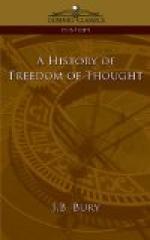One of the most striking results of the researches on the Old Testament has been that the Jews themselves handled their traditions freely. Each of the successive documents, which were afterwards woven together, was written by men who adopted a perfectly free attitude towards the older traditions, and having no suspicion that they were of divine origin did not bow down before their authority. It was reserved for the Christians to invest with infallible authority the whole indiscriminate lump of these Jewish documents, inconsistent not
[195] only in their tendencies (since they reflect the spirit of different ages), but also in some respects in substance. The examination of most of the other Old Testament books has led to conclusions likewise adverse to the orthodox view of their origin and character. New knowledge on many points has been derived from the Babylonian literature which has been recovered during the last half century. One of the earliest (1872) and most sensational discoveries was that the Jews got their story of the Flood from Babylonian mythology.
Modern criticism of the New Testament began with the stimulating works of Baur and of Strauss, whose Life of Jesus (1835), in which the supernatural was entirely rejected, had an immense success and caused furious controversy. Both these rationalists were influenced by Hegel. At the same time a classical scholar, Lachmann, laid the foundations of the criticism of the Greek text of the New Testament, by issuing the first scientific edition. Since then seventy years of work have led to some certain results which are generally accepted.
In the first place, no intelligent person who has studied modern criticism holds the old view that each of the four biographies of Jesus is an independent work and an independent
[196] testimony to the facts which are related. It is acknowledged that those portions which are common to more than one and are written in identical language have the same origin and represent only one testimony. In the second place, it is allowed that the first Gospel is not the oldest and that the apostle Matthew was not its author. There is also a pretty general agreement that Mark’s book is the oldest. The authorship of the fourth Gospel, which like the first was supposed to have been written by an eye-witness, is still contested, but even those who adhere to the tradition admit that it represents a theory about Jesus which is widely different from the view of the three other biographers.
The result is that it can no longer be said that for the life of Jesus there is the evidence of eye-witnesses. The oldest account (Mark) was composed at the earliest some thirty years after the Crucifixion. If such evidence is considered good enough to establish the supernatural events described in that document, there are few alleged supernatural occurrences which we shall not be equally entitled to believe. As a matter of fact, an interval of thirty years makes little difference, for we know that legends require little time to grow. In the East, you will hear of miracles which happened the day before




